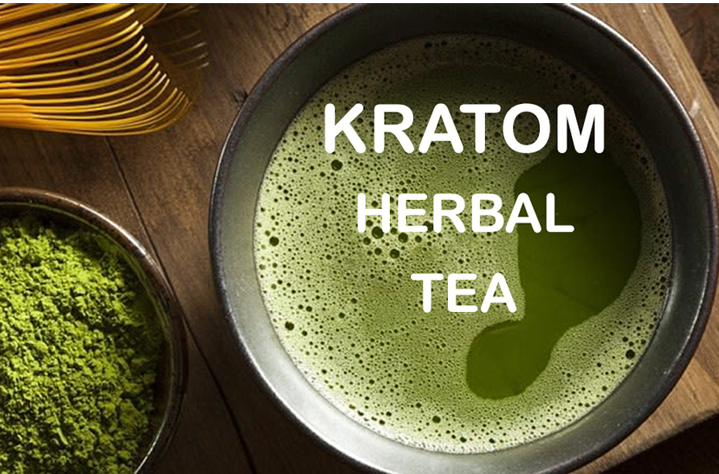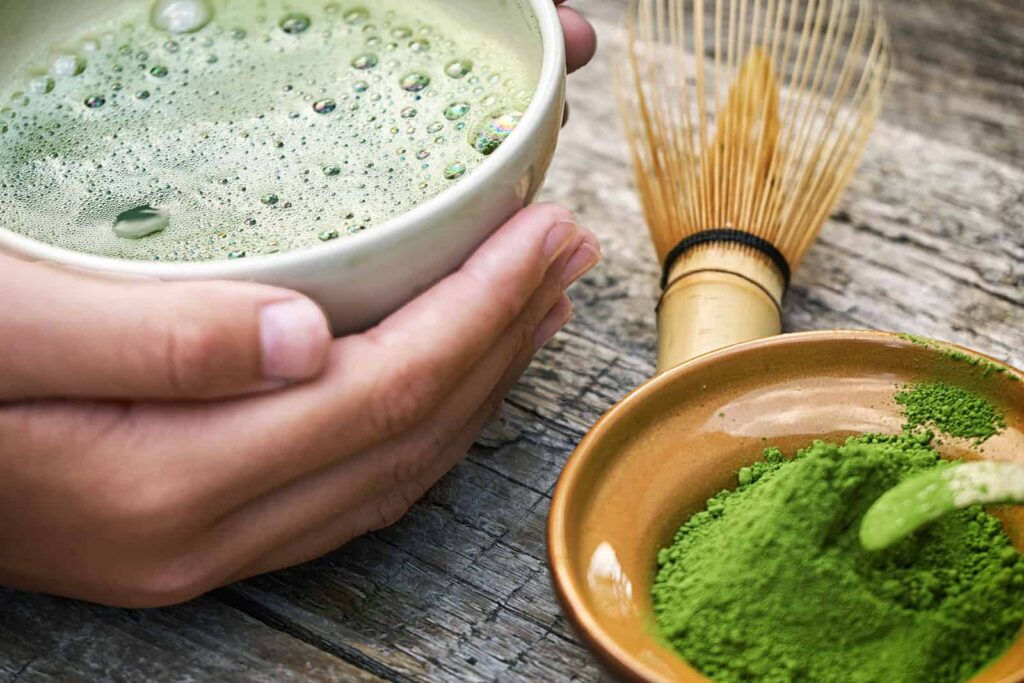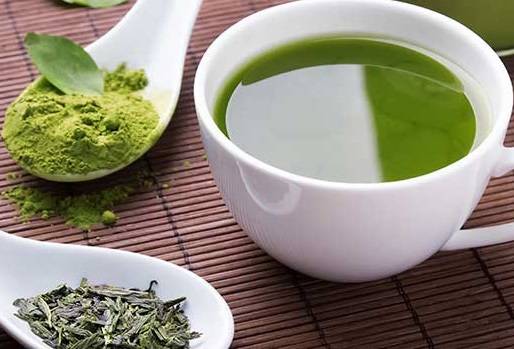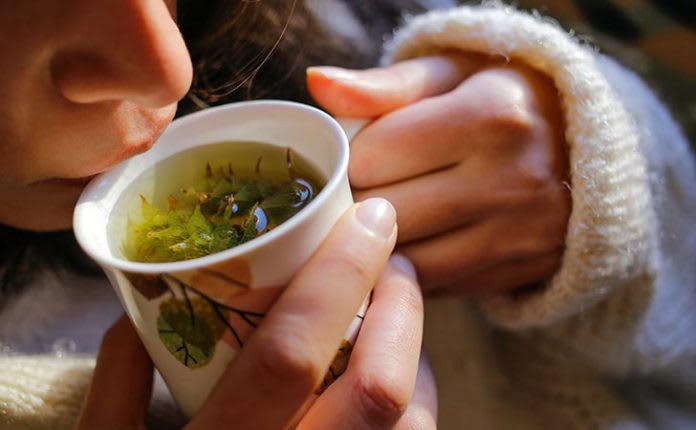
September 5, 2020

What is kratom tea?
A member of the coffee family, the kratom tree is native to Southeast Asia and mostly cultivated in Indonesia. Under friendly, tropical conditions, wild kratom trees can reach heights of 80 feet or taller.
When you hear people talk about kratom they are referring to kratom supplements or kratom tea products that consist of the kratom tree’s leaves. The leaves are pulled from the tree, dried, and then either crushed into smaller pieces or ground into a very fine powder.
In Southeast Asia, kratom leaves are traditionally chewed by the user, whereas in the U.S. they are more popularly used in powder or capsule form.
Although you may see mention of various kratom strains online, such as Maeng Da. or labels that refer to colors, most strain names are not indicative of actual kratom tea effects on the user. For more information refer to our guide on kratom strains.
Kratom tea effects and benefits
Kratom tea is considered an herbal tea. While it is a relative of the coffee plant, kratom differs in that it doesn’t contain any concentrations of caffeine like coffee and traditional tea. However, it is rich in alkaloids that may offer benefits to drinkers. People brew kratom tea for many reasons. Kratom leaves contain two unique compounds: Mitragynine and 7-hydroxymitragynine. When used in lower serving sizes, kratom tends to be more energizing.† In higher serving sizes kratom supports the body’s response to occasional pain and promotes relaxation.
How to make Kratom Tea
Kratom powder is by far the most popular way that Americans use kratom. Often times when kratom advocates talk about making kratom tea they are literally mixing kratom powder into water and then drinking the powder down with the liquid. However, it may not be enjoyable to a lot of people because of the texture and flavor.
When most people think of tea they picture a tea bag that strains the tea leaves from the water, so that only the liquid is consumed. This can be done with kratom as well! By properly straining the kratom tea the drinker can enjoy a much better flavor and reduce the plant matter that is consumed. This can all be achieved while still benefiting from the alkaloids in kratom (contrary to what some people think).
To brew kratom tea you have a few options: use tea powder or crushed leaf, or use kratom tea bags that are convenient and ready to brew.
Using Kratom Tea Bags
Many people just don’t like dealing with messy powders or loose leaf teas. For them, there is no substitute for kratom tea bags—an alternative that is definitely easier.
These work just like other tea bags; you simply place the tea bag in a mug and fill the mug with very hot water—but not boiling water (see our explanation below). The kratom tea bag should steep for 3 to 5 minutes until it achieves its typical amber color.
Using Kratom Powder
Kratom tea bags are somewhat uncommon in the marketplace, so kratom tea is often brewed using kratom powder or crushed kratom leaf. To do this, mix the kratom powder with hot water and let it steep. Some people will let the tea brew overnight, but it isn’t necessary. At least 5-10 minutes is what we would recommend.
Once your tea is brewed, you’ll need to strain the powder to remove it from the tea liquid. You can do this using a cheesecloth or coffee filter. If you are using powder it’s more likely to clog something like a coffee filter so you may need to use more than one. Crushed kratom leaf works well with a Breville Tea Maker (more on that below).
If you really want to change the taste, add an herbal tea bag to your brew, and don’t be afraid to flavor your kratom tea with honey and lemon.
Simple Kratom Tea Recipes
Once you’ve decided if you want to use a kratom tea bag or kratom powder, there are a few different recipes you can use to get your desired result.
Making kratom tea without a strainer
Measure out about one teaspoon of powdered kratom leaf.
Boil 2 to 4 cups of water.
It’s up to you how much to use, but more water will dilute the strong flavor.
Pour hot but not boiling water over the kratom powder in a large container with a pour spout, and stir until it is thoroughly mixed and no clumps of powder remain.
Most people like to sweeten their tea with honey. Lemon may also help with the flavor and enhance the tea.
Drink after cooling – some prefer to allow the powder to settle to the bottom before drinking.
Making kratom tea with a strainer
In a large pot, boil 4-6 cups of water.
Once you’ve reached a boil, add in your desired amount of kratom leaves or powder.
Let the mixture simmer for about 15 minutes.
Pour the contents through a coffee filter, strainer, or cheesecloth. If you’re using kratom powder, allow the powder remnants to settle to the bottom of the pot before straining. If you want to sweeten the whole batch, add sweetener or honey and stir. You can also sweeten each serving as you drink it.
Store the leftover tea in the refrigerator and enjoy it over ice or heat it up when you’re ready for your next cup.
How to make kratom sun tea
Fill a jug or pot with room temperature water.
Add your kratom powder, leaves, or tea bags into the water. We recommend using between 7-10 tea-bags or at least one bag per serving.
Place your pot in the sun for up to five hours (one hour minimum).
Occasionally stir the mixture.
If you want to infuse your kratom with lemon or another flavoring, add it to the mixture.
Serve the kratom tea over ice for a refreshing pick-me-up.
Note that with sun tea, your brew may not be as strong as it would when making the tea with hot water.
Kratom Tea FAQs
Is kratom tea stronger than kratom powder?
Most people actually brew their kratom tea from kratom powder, and kratom powder can produce many different results. The effects of kratom tea can range from relaxing to stimulating. People often wonder whether kratom tea is stronger than kratom powder, but the answer depends. That’s because the kratom tea’s strength depends entirely on how much kratom you use to prepare the tea.
Does boiling kratom kill the alkaloids?
No! This is a myth in the kratom community. Alkaloids in kratom are stable at temperatures above water’s boiling temperature. Mitragynine is the most abundant alkaloid in kratom. We performed tests on kratom tea to see how much mitragynine was present in the tea liquid after it cooled from boiling temperatures. Our conclusion was that hot water tea extractions are very effective and the mitragynine survived the high temperatures. 60-70% of the alkaloids from the raw kratom powder were transferred from the leaf to the water.
However, kratom has many different alkaloids and it’s possible that not all of them do as well as mitragynine does. Some users have reported that kratom tea offers a different experience than kratom powder mixed with water at non-boiling temperatures.
Discussion with a Kratom Tea Expert
For a first person account on the effects and benefits of kratom tea, and best brewing practices, we spoke with US Navy Veteran and Kratom Activist Andrew Turner to answer some common questions people have about the beverage.
Q: How would you compare your energy levels after drinking kratom tea versus green tea or another caffeinated tea?
A: The effects from kratom tea depend largely on how much you make it with. At small amounts, it can be as energizing as a cup of coffee. As you increase the amount, it becomes more relaxing.
Q: Why should someone choose kratom tea over another type of tea?
A: The biggest benefit is relaxation. For many people they will find that it could help with their overall wellness goals due to all the different alkaloids in the kratom leaf, but the main benefit is the relaxation it can provide.
Q: In terms of how to make kratom tea, how do you typically brew kratom tea? Is there one brewing method you prefer over another?
A: I typically use crushed leaf versus powder because it has a more distinct flavor.
For many years I would either brew it in an electric kettle or a pot on the stove, and then filter out the plant matter and pour the finished tea into glass bottles to cool. Now I use a Breville Tea Maker. I can put the tea in a separate basket, and it agitates up and down into the water while heating it.
This video is me, and this was my original method of making kratom tea. I rarely use citrus anymore, but it can help not only the flavor profile, but also change how the kratom alkaloids extract into the water.
Kratom tea recipe: https://youtu.be/VR-n9asB7l8
Q: If using kratom powder, what should the tea look like when it’s done?
A: Generally, when using powder to make kratom tea, it’s very difficult to filter off. Because of this, it turns a greenish hue, as there is a lot of powder in the mix. The nice thing about the Super Speciosa tea bags is the powder stays out of the tea, and you get the amber color that tells you the tea is finished. I’ve included a picture of what my perfect kratom tea looks like when it’s freshly made.
Q: How does the taste of kratom tea compare to other herbal teas?
A: Kratom tends to be more bitter and earthy tasting than other teas. It is why many people add natural sweeteners like honey, or brew it mixed with other strong flavored teas. Some use dried fruit, ginger, or added fruit syrups to sweeten the taste. It also tends to mellow a bit when cooled, so I tend to drink it as cold as I can possibly get it.
Q: How does the taste of kratom tea compare to other herbal teas?
A: Kratom tends to be more bitter and earthy tasting than other teas. It is why many people add natural sweeteners like honey, or brew it mixed with other strong flavored teas. Some use dried fruit, ginger, or added fruit syrups to sweeten the taste. It also tends to mellow a bit when cooled, so I tend to drink it as cold as I can possibly get it.
For more from Andrew Turner, follow him on Twitter.
Kratom Tea vs Other Types of Tea
There are so many varieties of tea, each with its own set of properties, flavors, and benefits. Even though kratom tea is not as widely known or available, it’s still just another type of tea. Recognizing how kratom tea compares to other types of more popular herbal teas, can help you identify if it’s something you want to try.
Camellia Sinensis Teas
Despite the many different varieties of tea on the market, most teas that are properly named come from one plant: Camellia sinensis. This small evergreen shrub grows in Asia, and the different harvesting and processing methods offer the unique flavor profiles we expect from black teas, green teas, oolong teas, and white teas. Each of these varieties has various homeopathic and traditional uses.†
Green tea
Possibly the most popular tea worldwide, green tea also often contains the most caffeine. The tea is “green” because it is derived from freshly-harvested leaves which do not undergo withering or oxidation before use.
Green tea has a subtle, bitter, astringent taste. It can be notably bitter if brewed too long. Because the tea leaves are fresh, green tea varieties often have more chlorophyll, minerals, vitamin C, and tannins than other types of tea.
Green tea is well-understood to have health benefits.† It is rich in polyphenols and catechins, which may play a beneficial role combating cancer, genital warts, cardiovascular disease, and obesity.† Compared to kratom tea, green tea offers less of a mood boost.†
Black tea
Black tea is another common caffeinated tea typically used in iced teas in the United States. Black tea is often used to create other brews, such as with bergamot oil to create Earl Grey tea, or with spices and milk to create Chai.
The flavor of black tea can vary significantly, and be light and sweet with notes of honey, or stronger and peppery with notes of floral, caramel, coffee, or chocolate. Poor-quality or badly brewed black tea can be particularly bitter.
Research indicates that black tea has antioxidant properties, and it may boost heart health by reducing blood pressure, LDL cholesterol, and the risk of stroke.† Black tea may also improve GI health, mental focus, and reduce both blood sugar levels and the risk of cancer.† Compared to kratom tea, black tea has a milder flavor with fewer mood boosting effects.
Oolong tea
Oolong tea, a favorite among tea aficionados, is a nice compromise for someone who likes both black and green teas. The oolong tea production process is similar to that of black tea, but it requires careful attention to the timing of the firing and oxidation stages.
Some oolong teas are light in color, with a fresher, greener taste. Others have a more roasted, woodier flavor, or they might offer an almost floral, sweet taste and aroma. In general, darker color corresponds with a deeper, nuttier flavor.
The health benefits of oolong tea are similar to those of black or green tea, including benefits to bone, brain, dental, and heart health. Oolong tea may also protect against certain types of cancer, decrease the risk of developing type 2 diabetes, and boost the metabolism.
White tea
White tea is made with the youngest leaves of the Camellia sinensis plant family, which are harvested and dried without any oxidation or additional rolling or processing. White tea leaves are named for the small silvery-white hairs that cover them, and they generally have less caffeine than other varieties.
White tea has a light, delicate taste that is slightly sweet and grassy, and it should never be bitter. Avoid consuming white tea with food because it can overpower the subtle flavor and light aroma of the tea.
White tea is rich in antioxidants, polyphenols, and catechins, and research indicates it may help improve oral health, prevent and fight cancer, help the immune system defend against infections, and improve bone and skin health.† Compared to kratom tea, white tea is very delicate tasting, much lighter in appearance, and has almost no mental effects.
Matcha Tea
Because of the similarities in appearance, you may wonder if matcha powder and kratom are comparable. However, other than being green powders that people use to make tea, they have little in common.
Matcha contains l-theanine and caffeine, whereas kratom contains two alkaloids of interest: mitragynine and 7-hydroxymitragynine. Daily servings of matcha typically won’t exceed 150mg of caffeine and 120 to 240mg of l-theanine.
Kratom mixes well with both matcha and coffee, and many users enjoy the added effects of the caffeine. Similarly, many users pair kratom tea with green tea, guayusa, or yerba mate. The l-theanine in green tea is especially useful for those with anxiety as it can counteract jittery feelings brought on by caffeine.
However, although there is some mythology out there about vendors substituting matcha powder for kratom and making the swap on unsuspecting consumers, this is unlikely. For one thing, matcha powder is actually more expensive than most kratom products! The myth probably springs from unscrupulous importers mislabeling kratom powder as “matcha” to avoid trouble with customs.
Herbal Teas
Herbal teas don’t come from the Camellia sinensis plant, so they are not true teas and lack some of the antioxidants of the classic teas. However, by brewing chamomile, or fruits like lemon, hibiscus, kratom, mint, rooibos, and more, you can open up an interesting world of new herbal teas—many of which offer their own benefits. In addition, herbal teas often lack caffeine, which is ideal for many consumers.
Plenty of herbal teas offer natural remedies for common issues. For example, research supports that ginger tea and peppermint tea may help reduce nausea.† Lavender tea and chamomile tea are both well-suited for nighttime use and relaxation. And yerba mate tea is a perfect pick-me-up in the morning if you need an energy boost.
Herbal teas are more similar to kratom tea in that none are made from the actual tea plant. However, the kratom plant is very unique, and each plant’s tea has its own properties.



